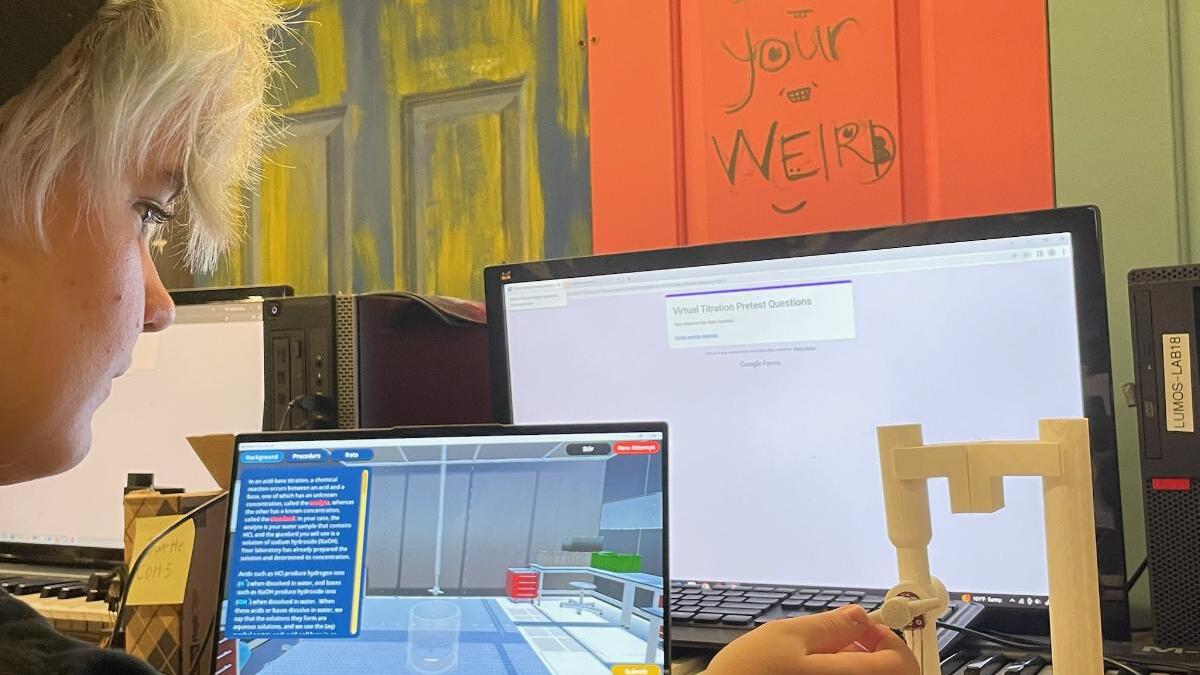Between microscopes, petri dishes, beakers and more, high school chemistry experiments for today’s large classes can be costly.
In a recently released study, an Arizona State University team researched an approach to provide a cost-effective high school chemistry lab experience that facilitates learning by combining virtual objects with tangible ones.
And it worked.
“Mixing digital with tangibles is a new and emerging technology, and we are just beginning to see its efficacy,” said Mina Johnson-Glenberg, associate research professor with ASU’s Department of Psychology.
ASU's School of Arts, Media and Engineering and the Department of Psychology collaborated on the project that was funded with a grant from the National Science Foundation. The team included Johnson-Glenberg, Asssociate Professor Robert LiKamWa, with the School of Arts, Media and Engineering, and ASU students Frank Liu and Christine S.P. Yu.
Experimenting with experiments
The researchers tested their approach on a titration experiment — a common high school demonstration that determines the concentration of a solution.
A 3D-printed burette (lab equipment used to dispense volumes of material) with a valve was placed next to the computer and synced up to a virtual titration lesson. The burette was an accurate facsimile, or copy, of the expensive glassware used in chemistry labs.
When students in one test group turned the valve on the 3D-printed burette, liquid was poured into the virtual vial on their computer screen.
A second group of students used a traditional computer keyboard with left and right arrow keys to control the amount of solution flow.
The 3D-printed burette was designed and built in ASU’s Meteor Studio; the project was led by Liu, a graduate research assistant in ASU’s School of Arts, Media and Engineering.

“We wanted to measure how well a gesture can be recreated using a 3D-printed burette and determine if the learning outcome improved,” Liu said.
The team also engineered the electronic interface to connect the 3D-printed burette with their original learning software.
“Our motivation was to design simple apparatuses with low-cost components and easily-produced 3D-printable shells with an eye on scaling for student accessibility,” said LiKamWa, who is also director of the Meteor Studio, a research lab that studies computer systems for augmented and virtual reality.
Yu, who earned a PhD in cognitive science at ASU, coded and ran the study in the Embodied Games Lab.
Both groups of study participants were tested before and after the experiment to determine whether the mixed-reality experience could provide an effective learning tool.
The results from 136 randomly assigned ASU students' scores confirmed that they acquired more knowledge of chemistry after the virtual tangible experiment than before.
Bonus benefits
Results of the study were even more enlightening than the team predicted.
An unexpected finding was that students with more prior chemistry knowledge performed significantly better in the mixed-reality experiment while those with limited chemistry experience were more successful using just the computer keyboard.
Researchers believe there may be an extra cognitive load associated with the addition of the haptic signal, and this may interfere with the learning signal for those students with lower prior knowledge of chemistry.
The study indicated that interactive, online lessons could be helpful to a spectrum of students. But, adding a tactile component may need to be supported by some pre-training for the students with less prior knowledge of chemistry, explained Johnson-Glenberg.
Another advantage of using a 3D-printed burette is that it makes room for mistakes, which is part of the learning process. Students can repeat the experiment as many times as needed.
“In a physical lab, students can’t do that because of the cost of different glassware,” said Liu. “This approach is a cheaper and more accessible alternative for students.”
The results of the study showed promise for a mixed-reality virtual titration program to become an alternative to the traditional hands-on chemistry lab experience.
“Overall, our efforts are contributing to multiple causes, providing a means of making chemistry education better for the environment, more affordable for schools, more accessible by remote and underrepresented communities, more engaging, fun and safer for the students,” Yu said.
Taking the results on the road
The team is in the early stages of employing their results in schools. They are currently working with a high school in Mesa, Arizona.
The vision is to send experiment kits to schools where they can be assembled. Those schools with 3D printers can create the experiment even easier.
“The pre-printed, inexpensive burettes would be shipped to schools that don’t have the resources to create an entire lab,” explained Liu, who has a passion for making education more engaging and accessible for students.
Liu says that a lot of students are not engaged by the current approach to education. The mixed-reality method is not only financially feasible for schools, but it takes advantage of technology that students are already engaged in — an important factor when bringing them to the science table.
“The thing that really makes me happy is seeing someone go through the experiences that I built and just light up,” Liu said. “They're like, ‘Oh this is so cool, I've never learned like this before.’”
Top photo: ASU student Reagan Ray participates in a study that measures the effectiveness of mixing virtual and tangible objects to learn chemistry. Photo by Mina Johnson-Glenberg
More Science and technology

Applied Materials invests in ASU to advance technology for a brighter future
For nearly 60 years, global giant Applied Materials has been hard at work engineering technology that continues to change how microchips are made.Their products power everything from flat-panel…

Meet ASU engineering students who are improving health care, computing and more
Furthering knowledge of water resource management, increasing the efficiency of manufacturing point-of-care health diagnostic tools and exploring new uses for emerging computer memory are just some…

Turning up the light: Plants, semiconductors and fuel production
What can plants and semiconductors teach us about fuel production?ASU's Gary Moore hopes to find out.With the aim of learning how to create viable alternatives to fossil-based fuels, Moore — an…


